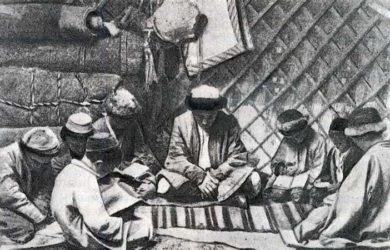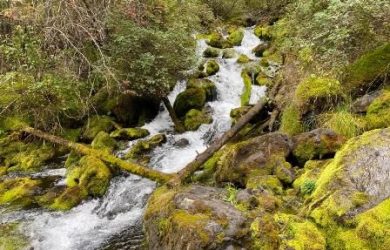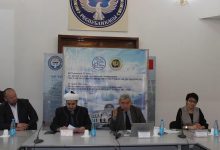Жапонияда жарияланған дерек
A Holy Place and Its Shaykh in the XIX Century
History of Southern Kazakhstan
Ashirbek MUMINOV
Foreword
The relations between the Qoqand (Khwāqand) Khanate (1798-1876) and its subject
tribes of Southern Kazakhstan found little reflection in official Qoqandian
historiography.1 A few studies have shown quite well that these relations were
complex; 2 however, new information is required in order to give full representation to
Qoqand–Southern Qazāq relations.
In 2004 we discovered one document that can provide fundamentally new
information about these relations.
Information about the Document’s Owner
The document’s owner was Ṣābir-Khwāja Sayyid-Khwājayev who died on August 14,
2011, a former resident of Suleymen Tileubayev street, section 2, Tashkent farm,
Tashkent tuman, Tashkent vilāyat, to the north of the capital of the Republic of
Uzbekistan. It was inherited by his son Bakhtiyār-Khwāja Ṣābir-Khwājayev. One may
note that this location is along the border with the Republic of Kazakhstan (the
Sarï-Aghash region of the South-Kazakhstan oblast’). We were assisted in examining
and photographing the document by the Ph.D-student in Arabic and Islamic studies
Muslim-Khwāja Ātayev, a relative of Ṣābir-Khwāja Sayyid-Khwājayev. Muslim-Khwāja’s
father, Rikhsī-Khwāja (Rizqī-Khwāja) ibn Sayyid-Khwāja ibn Āta-Khwāja (died in
January 9, 2004) was Ṣābir-Khwāja’s younger brother. However, due to a rivalry between
the brothers concerning the ownership of the document, we had no opportunity to see
it for a long time. This was because Ṣābir-Khwāja attempted to keep his murīds from the
Ramadan tribe of the Junior Horde of Kazakhs around him by holding on to the
document. After Rikhsī-Khwāja’s death, this rivalry disappeared.
1 Vakhidov 1998; Beisembiev 2009.
2 Maduanov 1992.
ASHIRBEK MUMINOV
142
Family Legends
Ṣābir-Khwāja Sayyid-Khwājayev received the document from his mother. His father
Sayyid-Khwāja (died in April 17, 1967), had suffered repression as an observant Muslim.
His mother wrapped the document up in its cloth cover and preserved it by keeping it
next to her body. Ṣābir-Khwāja knew only the following about his descent: 3
Ṣābir-Khwāja ibn Sayyid-Khwāja ibn Āta-Khwāja ibn ‘Azlar-Khwāja ibn ‘Azīz-Khwāja.
Sayyid-Khwāja’s father Āta-Khwāja lived in the vicinity of Tashkent and was a pīr
among the Kazakhs of the Junior Horde. He died in 1907 and was buried in the Ramadan
cemetery near Tashkent. The first person buried in this cemetery was the saint known
as Sad-Qara. A red flag has been set up over Āta-Khwāja’s grave, and many people come
to perform ziyārat on the spot.
The ancestor of these men was Zhalaŋ Ayaq Qozha, known as “Barefoot ‘Azlar.” He
belonged to one of the Kazakh khwāja (qozha) lineages, the Dīwāna (Duana, the branch
Zhalaŋ Ayaq Qozha). The family does not know much at all about him, only they believe
he is buried near the present-day city of Taraz, Kazakhstan (formerly Zhambul, Sozāq
rayon of the South-Kazakhstan oblast’ (See the photos below on the page 153 by Eralï
Ospanov, citizen of Shïmkent).
According to the first story preserved by the family, Khudāyār-Khān’s tax agents
(zakātchī) began robbing the population to excess, so at the people’s request Yalang
Āyāq-Khwāja acted as a mediator and got into an argument with the zakāt collectors.
When they spoke insultingly to him, the khwāja shouted out the war-cry “Alash!”4 and
the people all came together, beat the Qoqandians, and drove them off.
According to a second story, Khudāyār-Khān later had Yalang Āyāq-Khwāja caught
and brought to Qoqand. When he entered the palace in chains, the khān got up from his
seat and left. To the courtiers’ questions the khān replied, “Don’t you see? He has two
lions at his side.” After some conversation Khudāyār-Khān agreed to lower the taxes.
About the Document
The document is written on cream-colored locally handcrafted paper. The full size of
the paper is 109 x 54 cm, and it is made up of three layers. The oldest part is the
genealogy, which measures 50 x 30 cm. Two sheets of paper were glued to this part later.
The first is a piece of heavy cream-colored locally handcrafted paper added to the back
of the genealogy sheet. Later a piece of European paper was attached underneath this
for reinforcement. As a result, the document came to consist of three sheets in layers.
A cover was created for the document out of coarse, undyed cotton cloth measuring
30 x 138 cm. While the document was being hidden, the cover could be wrapped around
a person’s body. The length of its cord is 227 cm.
3 Henceforward, for purposes of continuity with the past, transliterations will follow usual
philological conventions rather than modern Uzbek spelling.
4 This war-cry was the common one for all nomadic tribes in this region – Kazakhs, Qara-Qalpāqs,
Qirghīzs, and Quramas against Qoqand. They were known as “Altï-Alash” (Six Alashes): three
Kazakh Hordes, Qara-Qalpāqs, Qirghīzs, and Quramas.
A HOLY PLACE AND ITS SHAYKH IN THE XIX CENTURY
143
The text also consists of three parts. Each part is written in a different hand.
The first text occupies an area of 54 x 24 cm. and is made up of 20 lines of writing, of
which the genealogy takes up 12 lines. The author’s name is kamīna-yi mukhliṣ-i mawrūthī
Sayyid Amānallāh ibn Sayyid Raḥīm-Tūra ibn Sayyid Nādir-Khwāja ibn Sayyid
Muḥammad-Khwāja-yi Kāsānī. The date of writing is 4 Rabī‘ II 1242/5 November 1826.
The person who commissioned the work could be any of Gadāy Khwāja-yi ‘Azīzlar ibn
Ḥājjī Khwāja-yi ‘Azīzlar’s three sons: Shāh-Muḥammad-‘Azīzlar, Sārī-Khwāja, or
Nazar-Khwāja. Gadāy Khwāja-yi ‘Azīzlar ibn Ḥājjī Khwāja-yi ‘Azīzlar’s grandfather is
Īr-Khāl-Muḥammad-‘Azīzlar (laqab: Yalang Āyāq [‘Barefoot’] Khwāja) ibn Ṣūfī Khwāja-yi
‘Azīzlar ibn Sayyid Manṣūr Khwāja. So we may know the full name of Yalang
Āyāq-Khwāja: Īr-Khāl-Muḥammad-‘Azīzlar ibn Ṣūfī Khwāja-yi ‘Azīzlar ibn Sayyid
Manṣūr Khwāja. Among the estimated persons who commissioned this work may also
be reckoned Sārī-Khwāja’s son Jīyān-Khwāja.
A text of 22 lines has been added to the first text. The area written upon measures 33
x 29.5 cm.
To the edges of the two texts described above have been added 16 paper tags, with a
total area of 109 x 24 cm. on the left side and 27 x 6.5 cm. on the right, with a total of 183
lines.
Bakhtiyār-Khwāja Ṣābir-Khwājayev and his family. Photo by Eralï Ospanov, July 2, 2013.
ASHIRBEK MUMINOV
144
Contents of the Document
The first text gives the genealogy of Khwāja Aḥmad Yasavī (d. 1166-1167), beginning
with Hāshim ibn ‘Abd Manāf (the prophet Muḥammad’s great grandfather) and ending
with Khwāja Aḥmad Yasavī. There are two peculiar features here. The first is that a
name new to the published genealogies – Tīmūr-Āta – is mentioned as Ibrāhīm-Āta’s
great-grandfather. This is the first time such a feature has been noticed among the
numerous genealogies of Khwāja Aḥmad Yasavī.5 The second peculiarity is that the
name Jalīl-Āta has been added next to that of Isḥāq-Āta in a different, later hand. The
reason for this must be that Yalang Āyāq-Khwāja and his progeny are descended not
from the famous hero Isḥāq-Bāb (mentioned here as “Isḥāq-Āta”), the ancestor of
Khwāja Aḥmad Yasavī, but from his younger brother, ‘Abd al-Jalīl-Bāb (mentioned here
as “Jalīl-Āta”).
At the beginning of the document a ḥadīth of the prophet Muḥammad is quoted:
“Whenever you are amazed by affairs of this world, seek aid at the tombs of the saints
(from the people of the graves); they shall never die.”6 It is unknown whether this
refers to the mazār of Khwāja Aḥmad Yasavī or the mazār of Yalang Āyāq Khwāja.
Five fatwas are quoted in the first piece of added text, four in Arabic and one in
Persian. They are taken from well-known books of the Ḥanafī madhhab: al-Khulāṣa by
Burhān al-Dīn al-Bukhārī (d. after 1074-1075), the Fatāwā Qāḍīkhān by Fakhr al-Dīn
Qāḍīkhān (d. 1196), and the Mukhtaṣar al-wiqāya by ‘Ubaydallāh ibn Mas‘ūd al-Maḥbūbī
(d. 1346). They deal with matters of profession of faith (shahāda), and affirm that
testimony given by aggressors and robbers is not to be accepted.
In the texts added after this, the names of the tribes of the murīds of Yalang Āyāq
Khwāja are given: Ramadan, Chumuchli, Balghali, Aq-börik, Qara-börik, etc.
It is indicated that the last information to have been included in this part is dated
Muḥarram 1255/March-April 1839.
Significantly, after the name of each tribe and its batïrs and biys is given, there is an
additional statement that they are accompanied by their troops (cherīk). In all, the
names of more than 50 tribes, batïrs, and biys are cited here. However, because the
names are written in an unprofessional hand, and in some places text has been lost due
to wear, establishing them all remains a matter for the future. In a number of instances
addressing these questions will require intensive labor in comparing archival
documents and other narrative works, and in conducting interviews in the regions of
Suzaq, Taraz (Zhambïl), and Tashkent.
The document is furnished with 37 seal impressions. However, it should be noted
that some of the impressions have been cut out of other documents and affixed to this
one. The reasons why this was done are among the problems that await future
clarification.
5 Muminov et al. 2008: 278-285.
6 See also: Muminov and Nurmanova 2009: 182.
A HOLY PLACE AND ITS SHAYKH IN THE XIX CENTURY
145
Mausoleum and tomb of Zhalaŋ Ayaq Qozha, Sozaq rayon of the South-Kazakhstan oblast’,
Photos by Eralï Ospanov
Conclusion
It follows that this document provides information about a rebellion by Kazakh tribes in
Southern Kazakhstan against the Qoqandians in 1839. The rebellion arose over a matter
of zakāt, and in several respects Islamic ideology played a considerable role in the
conflict. The Qoqandians robbed pastoral peoples with the justification that they were
adhering to the rules of sharī‘a, and as a consequence touched off a serious protest. Local
khwājas played an active role in the ideology of the resistance. The name of Khwāja
Aḥmad Yasavī and the tombs and descendants of saints figured prominently in the
dispute. This document provides us with important information about features of the
economic and ideological policies employed by the Qoqand Khanate.
Bibliographical references:
Beisembiev, Timur K. 2009. Kokandskaia istoriografiia. Issledovanie po istochnikovedeniiu Srednei Azii
XVIII–XIX vv. Almaty: TOO Print-S.
Maduanov, Seitqali M. 1992. Istoriia kazakhsko-uzbekskikh otnoshenii v XIX – nachale XX vv. Turkestan.
Muminov, Ashirbek, Anke Kuegelgen, Devin DeWeese, and Michael Kemper (eds.) 2008.
Islamization and Sacred Lineages in Central Asia: the Legacy of Ishaq Bab in Narrative and Genealogical
Traditions. Vol. 2: Genealogical Charters and Sacred Families: Nasab-Namas and Khoja Groups Linked to
the Ishaq Bab Narrative, 19th-21st Centuries. Almaty, Bern, Tashkent, Bloomington: Daik-Press.
Muminov, Ashirbek K. and Aytzhan Sh. Nurmanova 2009. Shaqpaq-Ata: Inscriptions of the Underground
Mosque and Necropolis / Editor B.M. Babajanov. Almaty: Daik-Press.
Vakhidov, Shadman Kh. 1998. Razvitie istoriografii v Kokandskom khanstve v XIX – nachale XX vv.
Dissertatsiia na soiskanie uchenoi stepeni doktora istoricheskikh nauk. Tashkent: Institut
vostokovedeniia im. Abu Raikhana Beruni (unpublished).
ASHIRBEK MUMINOV
146
SEALS
A HOLY PLACE AND ITS SHAYKH IN THE XIX CENTURY
147
LIST OF THE SEALS ON THE DOCUMENT
- Qāḍī Maḥmūd-Khwāja ibn Jān-Khwāja Ṣiddīqī, 1270/1853-1854;
- Kenzhe-Khwāja ibn ʻAlī-Aṣghar-Khwāja
- Qāḍī … ibn Muḥammad
- Muḥammad-Shāh ibn Muḥammad-Amīn Aʻlam-i ʻaṣrash bi-luṭf-i Ṣāḥib-i sharʻ-i matīn, 12..
- Aʻlam Dāmullā Sulṭān ibn Dāmullā Bāltū-Bāy
- Qāḍī ‘Umar-Khwāja Īshān Khān …, 1270/1853-1854
- Muftī Qārī Yūnus bi-luṭf-i jalīl …
- Aʻlam Khān-Khwāja ibn Aṣghar-Khwāja
- Aʻlam Shādī-Khwāja ibn Muḥammad-Khwāja Ḥasanī, 1231/1815-1816
- Muftī Muḥammad-Badal-Shāh ibn Mullā Muḥammad-Amīn-Shāh, 1240/1824-1825
- Qāḍī Khān-Khwāja ibn Mullā Shāh-Niʻmat-Khwāja ʻUmarī
- Muftī Shādī-Khwāja ibn Muḥammad-Khwāja Ḥasanī al-mutawakkil ʻalā-l-Lāh al-Ghanī
- Qāḍī ‘Īsā-Khwāja ibn Yūnus-Khwāja
- ʻAbd al-Rasūl-Khwāja ibn Yūsuf-Khwāja
- Muftī…
- Muftī Mullā Mīr Yaʻqūb-Makhdūm ibn Mullā Mīr Ṣāliḥ-i Marḥūm, 1270/1853-1854
- Aʻlam Mullā Mīrzā Aḥmad ibn Jān-Khwāja, 1270/1853-1854
- Aʻlam Muḥammad-Khān ibn … al-ʻAlawī al-Ḥanafī …, 1251/1835-1836
- ‘Azīzlār-Khwāja ibn ‘Abd al-Raḥīm-Khwāja ‘Umarī, 1270/1853-1854
- ‘Azīzlār-Khwājagī ibn ‘Abd al-Raḥīm-Khwāja ‘Umarī
- … -Khwāja ibn … -Khwāja
- Qāḍī-Kalān … …-Khwāja Īshān panāh …, 1241/1825-1826
- Qāḍī …
- Muftī Mullā Mīr ‘Azlār ibn Mullā Raḥīm-Khān, 1269/1852-1853
- Kenzhe-Khwāja ibn ʻAlī-Aṣghar-Khwāja
ASHIRBEK MUMINOV
148
General View of the Document.
A HOLY PLACE AND ITS SHAYKH IN THE XIX CENTURY
149
Upper Part of the Document with the Seals.
ASHIRBEK MUMINOV
150
Part of the Document with the Khwāja Genealogy.
A HOLY PLACE AND ITS SHAYKH IN THE XIX CENTURY
151
Section added to the First Text with the Names of Kazakh Tribes, their Biys and Batirs.
ASHIRBEK MUMINOV
152
Lower Part of the Document with the Other Kazakh Names











фотолары бар.